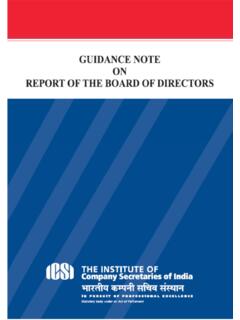Transcription of DO NO SIGNIFICANT HARM HANDBOOK
1 1DO NO SIGNIFICANT HARM HANDBOOKWHAT, WHY AND HOW OF DNSH ACROSS ENVIRONMENTAL AND SOCIAL SUSTAINABILITY-RELATED FACTORS2 TABLE OF CONTENTSI ntroduction 41 Background and the Principle of Do No SIGNIFICANT Harm 62 Practical Application of 'Do No SIGNIFICANT Harm' 93 DNSH Drivers and Challenges 114 Case Study: How to Apply the EU Taxonomy to Investments Criteria for Causing SIGNIFICANT Harm to an Environmental Objective The Taxonomy Review Process Case Study Summary 18 Activity One The Application of the Taxonomy Delegated Act DNSH Technical Screening Criteria to the Construction of New Buildings 20 Activity Two Application of the Taxonomy Delegated Act DNSH Technical Screening Criteria to Infrastructure for Personal Mobility.
2 Cycle Logistics 35 Activity Three Application of the Taxonomy Delegated Act DNSH Technical Screening Criteria to the Acquisition and Ownership of Buildings 42 Schedule 1 - Definitions 45 Schedule 2 - List of Annex I & II Taxonomy-Eligible Activities 48 Schedule 3 - Methodology for Assessing Substantial Contribution to the Objective of Climate Change Adaptation 52 Contacts 5434 INTRODUCTIONThis guide focuses on the Do No SIGNIFICANT Harm ( DNSH ) principle and technical screening criteria of the EU Taxonomy1 and how they may be implemented and disclosed in practice.
3 As investors gain a better understanding of how and to what extent investments substantially contribute to an environmental objective, they must ensure that these investments avoid significantly harming any of the environmental objectives, as well as adhere to minimum social safeguards. This is necessary in order to avoid economic activities benefitting from an investment, while on the one hand substantially reducing greenhouse gases or contributing to adaptation measures, and on the other, causing harm to the environment. The DNSH criteria are based primarily on minimum regulatory requirements and best practices within the European , a notable challenge arises for financial market participants ( FMPs ), because DNSH disclosures generally fail to adequately address the DNSH qualitative and quantitative criteria. The DNSH challenges are surmountable, as most of the criteria are tied to existing minimum regulatory requirements as well as best practices, and furthermore, allow for international equivalency.
4 This guide demonstrates how key economic factors can not only effectively address the DNSH disclosure challenges, but also illustrates how they may use the EU Taxonomy to guide strategic environmental goals and related decision-making, throughout the life cycle of that economic overarching aim of the DNSH guide is to assist FMPs to evaluate DNSH criteria applied to the EU Taxonomy, and to instill awareness among actors in the economy of the benefits of sharing DNSH data at the earliest stage possible. Our DNSH case study (the Case Study ) is representative of a new construction project, pre-construction stage, located in a coastal urban area within the EU. The due diligence process for the Case Study concerns the entire value chain of the activity including the operations, products, services and supply chains. 1 The EU Taxonomy was developed by a Technical Expert Group ("TEG") convened by the European Commission during 2018 as part of an ambitious package of measures supporting its comprehensive strategy on sustainable finance.
5 The European Commission has taken the recommendations of the TEG as the basis for the Delegated Acts (Annex I and II) published in April 2021, supplementing the Taxonomy Regulation (EU 2020/852). These Annexes provide detailed qualitative and quantitative technical screening criteria that define the thresholds for substantial contribution to two climate objectives and do no SIGNIFICANT harm to two climate and four environmental objectives. Further development of the EU Taxonomy is being undertaken by the Sustainable Finance Platform with additional Technical Screening Criteria ("TSC") to be published at the end of December StapletonHead of Funds & Investment Management Maples Group Dawn SlevinManaging Director Environmental Liability Solutions Europe Ltd. (ELS Europe)Lukas SimonManager Sustainable Finance Solutions Frankfurt School - UNEP Collaborating Centre for Climate & Sustainable Energy Finance The Case Study underlines how owners and developers of large construction and infrastructure projects, can at minimal cost, greatly improve their DNSH and other relevant ESG (sustainability-related) disclosures and thereby enable Real Estate Investment Trusts and other investors to incorporate their sustainable projects into their EU Taxonomy aligned and / other sustainable investment need to know how, and to what extent, the EU Taxonomy technical screening criteria have been applied.
6 EU Taxonomy eligible activities may include ongoing revenue-generating operations, capital expenditure ( CapEx ) and / or operational expenditure ( OpEx ). Strategic decisions made early in the development pre-construction stage by developers and planners will ease the disclosure burden on all stakeholders and ensure the environmental ambitions of the project are rewarded. All references in this guide to SFDR Final Draft Level 2 include the proposed changes contemplated by the Taxonomy Regulation s draft Regulatory Technical used within are set out in Schedule 1 - Definitions on page BACKGROUND AND THE PRINCIPLE OF DO NO SIGNIFICANT HARM The European Green deal is the European Commission s roadmap of the major policy and legislative proposals required to make Europe carbon-neutral by 2050. It builds on the European Commission s Action Plan on Financing Sustainable Growth (the Action Plan ) which imposes a number of regulatory requirements on asset managers.
7 The European Green Deal is a road map for making the EU s economy sustainable and further moves sustainable objectives to the core of EU policy. It proposes a Renewed Sustainable Finance Strategy to ensure that the EU s financial systems support the transition of businesses towards sustainability in the context of recovery. It focuses on three main areas: 1. Strengthening the foundations for sustainable finance by creating an enabling framework, with appropriate tools and structures2. Increasing opportunities for citizens, financial institutions and corporates to enhance sustainability3. Reducing and managing climate and environmental risks while ensuring social risks are taken into account where relevant The principle of do no harm underpins the European Green Deal, which includes a green oath that requires future European Commission initiatives to uphold this principle. As part of the Action Plan, the European Commission has published a raft of legislation which includes the SFDR and the Taxonomy Regulation.
8 The SFDR seeks to avoid divergent measures across EU Member States to ensure end-investors are offered standard and comparable information, in order to make an informed decision and to determine what activities are environmentally sustainable. It lays down harmonised rules on transparency for financial market participants, based on the type of financial products (SFDR Articles 6, 8 and 9) that are being marketed. In addition, the Taxonomy Regulation provides a framework to classify environmentally sustainable economic activities. The Taxonomy Regulation establishes the conditions to create a unified classification system and sets out the criteria and factors to be taken into account for a product or activity to be deemed environmentally sustainable . In keeping with the green oath that underpins the Green Deal, both the SFDR2 and the Taxonomy Regulation3 apply the principle of Do No SIGNIFICANT Harm.
9 The SFDR introduced the principle of 'do not significantly harm which considers an investment to be a Sustainable Investment if it contributes to an environmental or social objective and does not significantly harm any other environmental or social objective as set out in the SFDR. This means that financial products that have a sustainable investment objective must also consider the adverse impact indicators as part of their disclosures of no SIGNIFICANT harm to sustainability Taxonomy Regulation provides for a framework to classify a Sustainable Investment. It sets out the criteria and factors to be considered for a product or activity to be deemed environmentally sustainable , however it does not set out the technical screening criteria for social objectives. The Taxonomy Regulation sets out a list of economic activities with performance criteria for their contribution to six environmental objectives, namely: 1.
10 Climate change mitigation2. Climate change adaptation3. Sustainable use and protection of water and marine resources4. Transition to a circular economy5. Pollution prevention, control and protection6. Restoration of biodiversity and ecosystems (the Environmental Objectives ) 2 The SFDR seeks to harmonise ESG disclosures to enable investors to make informed choices. The SFDR requires financial market participants and financial advisers to disclose how they integrate sustainability risks in their investment decision making process and advisory processes. 3 The Taxonomy Regulation sets out the criteria and factors to be considered for a product or activity to be deemed environmentally CHANGEMITIGATIONCLIMATE CHANGEADAPTATIONSUSTAINABLE USE OF WATER AND MARINE RESOURCESPOLLUTIONPREVENTIONHEALTHYECOSY STEM8In order for an activity to qualify as being environmentally sustainable , it must contribute substantially to one of the Environmental Objectives, while also complying with each of the following criteria: No SIGNIFICANT Harm: The activity does not significantly harm any of the Environmental Objectives Technical Screening Criteria: The activity must comply with technical screening criteria for each relevant Environmental Objective Minimum Social and Governance Safeguards.




